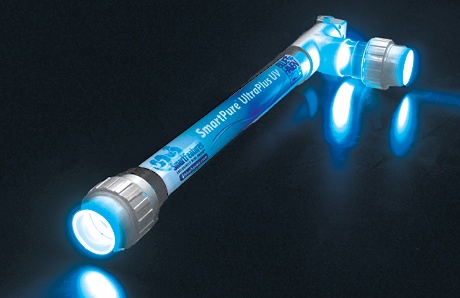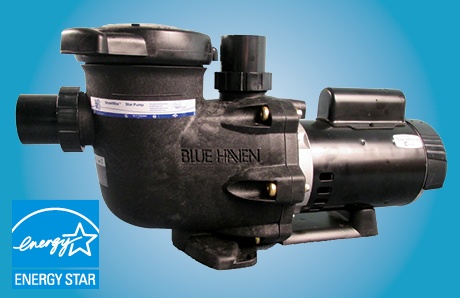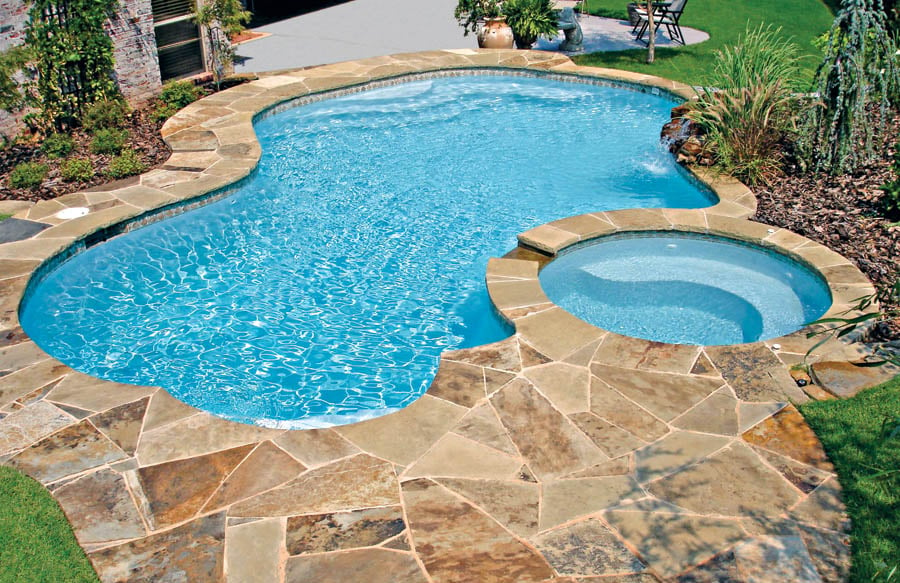—Avoid these mistakes when choosing your pool’s technology options

—Updated September 27, 2018
When buying a swimming pool, you can actually commit a variety of sins relating to technology and equipment choices but still have a beautiful backyard resort.
But for a cost-efficient, environmentally friendly, easy-to-own aquatic retreat, the smart approach is to steer clear of the seven missteps outlined here.
Every pool buyer would like a new pool that provides the most automated, fuss-free, comfortable experience possible. But many buyers make a series of transgressions when selecting options for pool systems and tech features. Let’s take a look at these potential pitfalls so that you are better informed on how to avoid them.
1. Passing on an automatic pool cleaner
 Building a new pool without a pool cleaner is nothing short of a crime. Sure, you could save several hundred to more than a thousand dollars up front on your purchase by forgoing this device. But at what real cost? Do you want to spend hours each month scooping leaves and debris from your pool—or staring at dirty water?
Building a new pool without a pool cleaner is nothing short of a crime. Sure, you could save several hundred to more than a thousand dollars up front on your purchase by forgoing this device. But at what real cost? Do you want to spend hours each month scooping leaves and debris from your pool—or staring at dirty water?
Ask anyone who owns a backyard pool: Unless they have an enclosed/indoor pool or an automatic pool cover used year-round, they will say that an automatic cleaner is one of the best investments you can make when buying a pool.
Be sure to choose a model that’s quiet and energy-efficient. You also want to choose the appropriate kind of cleaner for your pool and backyard. Each category of cleaner offers performance advantages for certain kinds of pool-site conditions.
For example, suction cleaners work better in desert areas where the wind blows dust and silt into the water; pressure units are better where seasonal trees drop leaves into the water. Be sure to ask your pool builder for a recommendation.
2. Skipping on an alternative sanitizing system
 Quite simply, no reason exists for relying on traditional tablet or liquid chlorine as the primary method for sanitizing pool water.
Quite simply, no reason exists for relying on traditional tablet or liquid chlorine as the primary method for sanitizing pool water.
Using old-school chemicals makes it harder to balance pool water and compels you to buy, store, and handle the caustic disinfectants. Even if you have a pool service, using your father’s pool sanitizer is still nothing less than a sin—unless you want your family swimming in a chemical soup.
Off-the-shelf chlorine increases the possibility for chlorine byproducts to rear their ugly heads. These nasty compounds—known as chloramines—are the culprits behind swimming conditions that are harsh on your body in multiple ways. They cause red, stinging eyes, bleached hair, itchy skin, and that awful bleach-like odor.
For crystal-clear water that’s easy on your skin, hair, and eyes, you have much better water-treatment options: ozone systems and ultraviolet (UV) germicidal light. These technologies provide a swimming environment that’s far superior to a chlorinated one.
Appropriate for any residential pool, an ozone or UV sanitizer system will dramatically reduce the amount of chlorine needed to maintain water. An ideal option is a hybrid unit that uses both; together, they produce unmatched levels of water sanitation and water clarity—without any toxic byproducts left behind to aggravate swimmers!
Salt systems: A word of caution:
If you think a salt system is an ideal alternative to traditional chlorine, think again: Electrolytic salt systems still produce a form of chlorine—and therefore, a chemical-laden pool. Plus, the salt content can make the water corrosive. Depending on the building materials, equipment, and accessories used in and around your pool and deck, a salt system can be problematic. Rock waterfalls, accent boulders, and nearby landscaping can also fall victim to deterioration from saltwater. Although salt systems were popular for a while, many pool builders have stopped using them due to damage and customer complaints.
3. Choosing a sand filter
 Which pool filter does a better job of cleaning water: sand or cartridge?
Which pool filter does a better job of cleaning water: sand or cartridge?
One way to judge is by how finely the unit can filter dirt. That means capturing tiny particulate matter. Particulate size is measured in microns. (For reference, a grain of table salt runs about 90 microns.)
When it comes to results, pool cartridge filters outperform sand ones; cartridge material can grab particles as tiny as 5 to 10 microns—compared to 25 microns for sand.
But the news on cartridge units gets even better: Along with helping produce beautiful, sparkling water, they save on maintenance and water use.
Most models of sand filters require a process called backwashing. In addition to the required hassle, this task causes a substantial loss of pool water—thousands of gallons each year!
On the other hand, a cartridge filter is water-sparing and ultra-low maintenance. No backwashing is needed. Depending on its size and your pool use, the cartridges will need a simple hosing down. And if you ask your pool builder for a large model with plenty of storage capacity, you will need to clean your pool filter only a few times each year!
Cartridge material with Microban® will stay fresher for even longer. This antimicrobial product protection is woven into the material during its manufacture, and it will inhibit the growth of invading microorganisms—mold, algae, and fungus.
4. Settling for yesterday’s pool pump
 Pool pumps run key functions such as cleaning, filtration, heating, and water features. Like any electronic product, some may cost less up front—but lack the technology that makes them more affordable to operate over the long run.
Pool pumps run key functions such as cleaning, filtration, heating, and water features. Like any electronic product, some may cost less up front—but lack the technology that makes them more affordable to operate over the long run.
In some pools, a traditional single-speed pump will get the job done. But often, it will do so with a noisier motor, shorter lifespan, and much higher electric bill. Particularly if you have a pool-spa combination, water features, in-floor cleaning system, or supplemental circulation system, consider a modern two-speed or variable-speed pool pump.
Investing in this technology will yield significant savings over months and years of operation. The reason: To power daily functions, a single-speed pump typically needs to run six to eight hours a day—requiring the same high electricity load the entire time.
However, with a two- or variable-speed pool pump, the motor can operate at different speeds as actually needed. These motors draw less electricity when performing certain functions, such as filtration. Although this kind of pump may need to operate for more hours in the day—sometimes up to 12—it reserves higher speeds for more demanding needs, such as running the cleaner.
The net result is a big win. At lower, more efficient speeds, total energy use is slashed, saving significant costs: two-speed models up to 70 percent; variable-speed models up to 90 percent.
Because the pump runs more hours a day, filtration is also enhanced; that means cleaner water. In addition, the motor on these pumps will run quieter and last longer.
5. Accepting incandescent pool lighting
 Yes, standard incandescent bulbs have lit up swimming pools for decades; one will illuminate your pool, too. But a bulb can’t hold a candle to newer color-changing LED technology.
Yes, standard incandescent bulbs have lit up swimming pools for decades; one will illuminate your pool, too. But a bulb can’t hold a candle to newer color-changing LED technology.
Incandescent lighting gobbles electricity. Its high wattage causes a great deal of heat to go through the light fixture—which can reduce total operating hours. In a pool, the heat also creates a vacuum effect in which water can get sucked into the fixture and damage the entire unit.
As for aesthetics, incandescent is a big loser as well. Among industry professionals, the joke is that the light it creates in a pool produces all the style and visual appeal of a headlamp from an oncoming freight train.
For greater energy efficiency and dazzling colors, today’s smart LED pool lighting systems are light years ahead. For starters, LEDs (light emitting diodes) use a tiny fraction of the energy required by its incandescent counterpart. Quality LED systems boast operating lifespans of more than 50,000 hours!
Along with significant power savings, the beauty that LEDs deliver puts them head and shoulders above incandescent bulbs. LEDs create incredible jewel-tone colors around the pool & spa for an after-dark sensation.
You can set the lighting to remain on your favorite colors: typically red, blue, white, blue, green, gold, and pink. But you can pump up the evening drama even more: Top-of-the-line LED systems offer dazzling “light shows.”
In these dynamic displays, hundreds of colors flash and transition at different speeds to create “themes” that range from relaxation to holiday celebrations.
6. Failing to invest in automation and remote controls
 Sure, you can watch television without a remote control, but would you want to? The same can be said about operating today’s swimming pools.
Sure, you can watch television without a remote control, but would you want to? The same can be said about operating today’s swimming pools.
A variety of pool automation and remote control systems can make running pool systems and activating various functions ultra-convenient. Particularly if you have a spa, water features, two- or variable-speed pump, or water slide, automation will make it easier to manage certain features and to cut energy use.
This technology can automate functions such as pool cleaning, purification, filtration, heating, spa jets, water features, and spa and landscape lighting. Simple, affordable units control four or five functions. More sophisticated ones can handle additional ones and do so with greater functionality. For example, they can control solar heating systems and color-changing LED light shows, and let you calibrate the flow level of water features (e.g., make a fountain spray taller).
You can take convenience to the next level by including a remote device with your automation system. Several styles are available. One is a base unit that sits on a table or that’s mounted on a wall. A handheld device is another option; some of these units even float and are fully waterproof for use in your pool & spa.
An increasingly popular choice is a remote internet platform. You can connect to your pool when you are away from home, and program a variety of group functions from a desktop PC, Mac, smartphone or tablet.
7. Accepting old-fashioned pool plaster
 While a pool’s interior surface material may not fall into the “technology” category per se, options for it do represent important industry advances that you don’t want to overlook.
While a pool’s interior surface material may not fall into the “technology” category per se, options for it do represent important industry advances that you don’t want to overlook.
Used for decades for pool interiors, marcite plaster is tried and true. However, it is also tried and true to be vulnerable to etching, mottling, deteriorating from ultraviolet exposure, and showing stains from water-chemistry imbalances.
Much better options are available. One is a colored quartz aggregate finish. This upgrade will cost more than marcite, but the serious value the material delivers makes the investment well worth it.
Quartz is one of the hardest minerals on earth. The industrial giant 3M originally pioneered the use of this mineral in pool finishes; its specialists developed a special colored aggregate to blend into marcite plaster.
The result is an interior pool finish that’s more attractive and more durable. It comes in a variety of colors that resist chipping, fading, and staining. With these attributes, quartz will last longer and look better. In fact, unlike a plain marcite finish, it’s rare to hear of a quartz pool requiring an acid wash—a costly, hassle-filled project.
Pebble-type finishes are another desirable alternative to marcite. These specialty finishes combine marcite with small stone pebbles. Typically, pebble finishes are best suited for higher-end projects. Their superb beauty does come at a price: They add at least several thousand dollars to the pool cost and can extend construction time.
Choose technology wisely for the best results
Swimming pool ownership is all about having a backyard retreat for fun and leisure. Maximize the benefits by avoiding buying missteps that prevent you from realizing the full benefits of pool ownership.
Minimize regrets by making the best choices up front: Purchase an automatic pool cleaner, choose alternative purification, pick a cartridge filter, invest in automation and remote devices, opt for LED lighting, and upgrade the material for your pool’s interior finish. The result will help you achieve maximum comfort and enjoyment for years to come.




.jpg?width=1490&name=rock-waterfall-slide-pool%20(1).jpg)